Chapter 8: Bindings and Folds
STANDARD BINDING TYPES
There are many ways to bind loose sheets, folded sheets, or signatures together—each with its own set of aesthetic, cost, and durability considerations. Here is an overview of the binding options most readily available. Consult the chart following this section to compare the cost, durability, and aesthetic attributes of these binding methods.

PERFECT BINDING
Signatures are gathered in a stack rather than nested. The spine side of the stack is milled to remove the folded edges. Melted adhesive is applied along the spine edges of the pages. The cover is applied while the glue is hot and wrapped around the book. The book is trimmed on a three-knife trimmer.

SADDLE STITCH BINDING
Cover and signatures are nested one within the other and hung over a chain or “saddle.” Covers are scored and folded on the same machine and then laid on top of the signatures. Cover and signatures are wire stitched (stapled) at the center of the spine, and then trimmed.
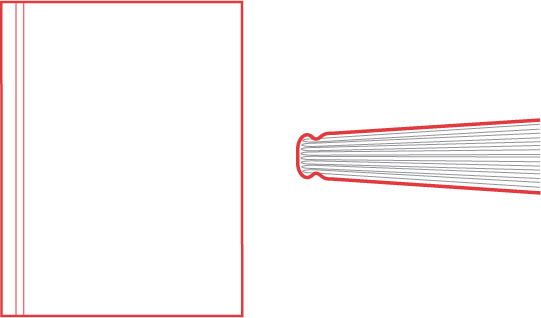
CASE BINDING (SMYTHE SEWN)
Gathered signatures are assembled and sewn along the spine. The sewn book block is then glued on the spine and trimmed on three sides. The trimmed book block is then glued to an outer cover, which is manufactured separately. The case is held to the book block by endsheets attached to the first and last signatures and glued to the inside.
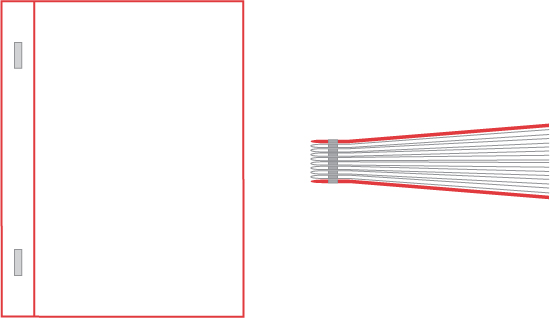
SIDE STITCH BINDING
Cover and individual pages or signatures are collated and assembled into a stack and then wire stitched (stapled) at the bound edge.
SCREW AND POST BINDING
Cover and signatures or individual pages are collated and assembled in a stack and trimmed on all sides, then drilled and fastened together with posts held on by screws. Screws can be unscrewed to add or remove pages as needed.

PLASTIC COMB BINDING
Trimmed covers and individual pages are assembled, collated, and held together by a plastic comb that is opened, inserted into drilled holes, and then closed. Comb can be opened to insert more pages as needed.
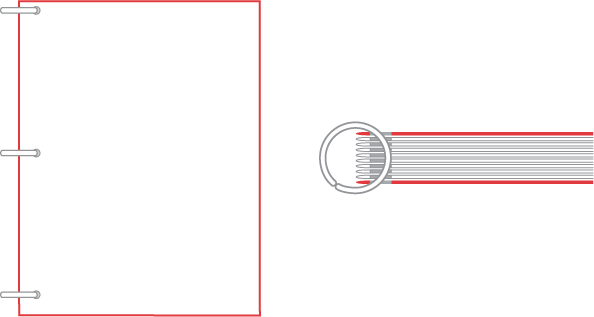
RING BINDING
Trimmed covers and individual pages are assembled, collated, and held together by individual rings. Or individual pages are assembled, collated, and inserted into a binder with rings. Rings and binders come in a variety of sizes and colors. Pages can be added or subtracted as needed.
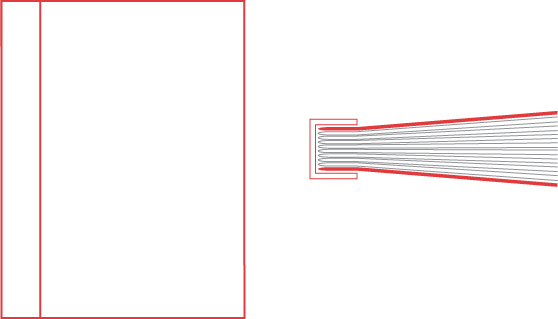
TAPE BINDING
Signatures and covers are assembled, collated, and trimmed on all sides. A strip of flexible cloth tape that contains glue is applied on the edges of the spine and heated. The glue melts and spreads, gluing the covers and signatures together.

SPIRAL AND DOUBLE-LOOP WIRE BINDING
Trimmed covers and individual pages are assembled, collated, and held together by a spiraled piece of plastic, wire, or doubled wire inserted into drilled holes.
WHICH BINDING METHOD WORKS BEST?
Bindings differ in their appearance, cost, and function. Some binding styles are suitable for publications with many pages, whereas others will only work for those with a limited number of pages. Some methods allow pages to lie flat, whereas others don’t. Durability and cost are other considerations. Saddle stitching, for instance, is relatively inexpensive but not as permanent as case binding. The following chart should give you a better idea of which options will best suit your publication’s design and budget.
| Binding Style | Case |
| Girth | 3” for hardcover, 1 3/4” for paperback |
| Lays Flat | Yes |
| Printable Spine | Yes |
| Durability | High |
| Relative Cost | High |
| Advantages | Strength, durability, and a look of quality. |
| Limitations | Most costly option. Requires more production time. Requires signatures. |
| Binding Style | Perfect |
| Girth | Up to 2 3/8” |
| Lays Flat | No |
| Printable Spine | Yes, for 1/8” and larger |
| Durability | Moderate |
| Relative Cost | Low |
| Advantages | Inexpensive for moderate runs of of 1,000–5,000. Can bind single sheets. |
| Limitations | Paper grain must run parallel to the binding edge. Image area may be lost in gutter. |
| Binding Style | Saddle Stitch |
| Girth | Up to 1/2” |
| Lays Flat | Yes |
| Printable Spine | No |
| Durability | Moderate |
| Relative Cost | Low |
| Advantages | Fast and inexpensive. Can easily accomodate inserts. |
| Limitations | Requires signatures. Pages must be in increments of four. May need adjustments for creep. |
| Binding Style | Side Stitch |
| Girth | Up to 1” |
| Lays Flat | No |
| Printable Spine | No |
| Durability | High |
| Relative Cost | Low |
| Advantages | Fast and inexpensive. Variety of wire styles and widths available. |
| Limitations | Pages won’t lie flat when open. Requires a minimum 1” margin. |
| Binding Style | Screw and Post |
| Girth | Up to 1” |
| Lays Flat | No |
| Printable Spine | No |
| Durability | High |
| Relative Cost | High |
| Advantages | Easy to insert additional pages. Can accommodate pages of different materials. |
| Limitations | Hand assembly is time consuming and not appropriate for large quantities. |
| Binding Style | Tape |
| Girth | Up to 1 3/4” |
| Lays Flat | Yes |
| Printable Spine | No |
| Durability | Moderate |
| Relative Cost | High |
| Advantages | Durable option that is less costly than case binding. Tape comes in a range of colors. |
| Limitations | Requires signatures. Pages must be in increments of four. |
| Binding Style | Plastic Comb |
| Girth | Up to 1 3/4” |
| Lays Flat | Yes |
| Printable Spine | Possible with foil stamping |
| Durability | Low |
| Relative Cost | Low for small runs |
| Advantages | Widely available. Can be reopened to insert other pages. Facing pages align. |
| Limitations | Time consuming and costly for large quantities. |
| Binding Style | Spiral |
| Girth | Up to 2” and folds over 360° |
| Lays Flat | Yes |
| Printable Spine | No |
| Durability | Moderate |
| Relative Cost | Moderate |
| Advantages | Well suited to short runs. Can accommodate pages of different materials. |
| Limitations | Because of jogging, crossover designs may not align. |
| Binding Style | Ring |
| Girth | Up to 3” |
| Lays Flat | Yes |
| Printable Spine | Binders can be screen printed |
| Durability | Low |
| Relative Cost | Cost of materials for in-house hand assembly |
| Advantages | Easy to insert additional pages. Can accommodate pages of different materials. |
| Limitations | Hand assembly is inappropriate for large runs, but good for custom applications. |
FOLD BASICS
Basic valley and mountain folds are used to create a series of peaks and troughs, which make up all common fold styles.
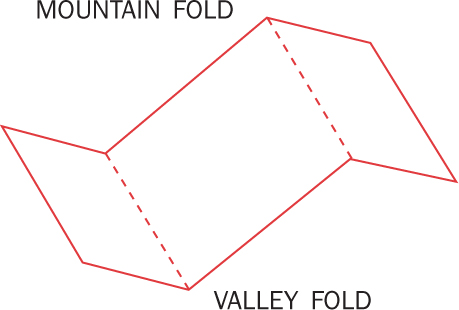
COMMON FOLD STYLES
Fold styles have standard names that should be used when communicating with printers and binderies. Following is a list of some of the most common styles and their names.
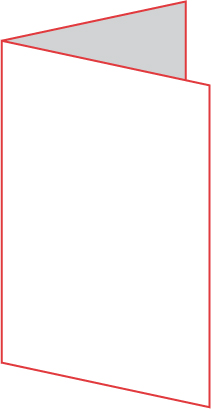
FOUR-PAGE SIMPLE FOLD
One fold made along either the short or long dimension of the paper resulting in four panels or pages.

SIX-PAGE ACCORDION FOLD OR Z-FOLD
Two simple folds where one fold bends in the opposite direction of the other resulting in six panels or pages. Accordion folds can comprise six, eight, ten, and sometimes twelve panels or pages.
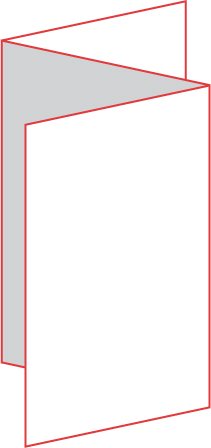
FOUR-PAGE SHORT FOLD
A simple fold made asymmetrically so that two pages or panels are larger than the others.
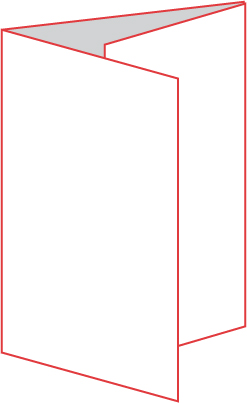
SIX-PAGE BARREL OR ROLL FOLD
Two simple folds where the outer edges of each panel or page are folded in toward the other resulting in six panels or pages. Barrel or roll folds composed of more than six panels or pages are often called rolling folds and can consist of many panels or pages.

EIGHT-PAGE GATEFOLD
A barrel fold with an additional fold in the center, resulting in eight panels or pages.
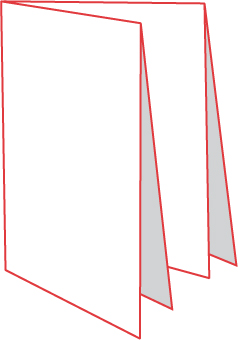
EIGHT-PAGE FRENCH FOLD/SIXTEEN-PAGE SIGNATURE
Multiple fold where the paper is first folded in one direction, then folded perpendicular to the first fold. This configuration is also used when creating sixteen-page signatures.
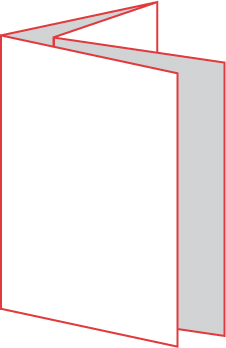
EIGHT-PAGE PARALLEL FOLD
A combination of a barrel fold and an accordion fold that forms eight panels or pages.
TOLERANCES FOR GATEFOLDS, BARREL, OR ROLL FOLDS
Gatefolds, as well as barrel or roll folds, require special allowances so that the outer panels or pages of a piece will overlap those within. Although the following standards apply to text weight papers, tolerances may vary slightly with other types of paper.

Gatefolds require an additional 1/8 inch (3.175 mm) on the outer panels (b and c) in the fold sequence.

Roll or barrel folds require an additional 1/8 inch (3.175 mm) for each panel in the fold sequence so that each panel is 1/8inch (3.175 mm) larger than the next.

